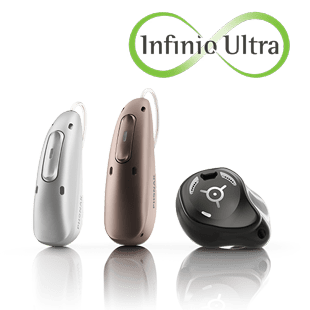
The core of hearing technology: Firmware
Firmware is essential to hearing technology, driving overall device functionality. Learn how an integrated approach to firmware in Phonak and Advanced Bionics devices ensures a seamless experience across the hearing continuum.
When you think about hearing devices such as hearing aids or cochlear implants, what comes to mind first? Is it the sleek, compact devices that sit behind or inside the ear, or perhaps the software applications that allow users and professionals to adjust settings?
Have you ever wondered what truly powers these hearing solutions? The answer lies in something less visible yet utterly crucial: firmware. Firmware is the embedded software that controls a device.
Just as the patty and fillings in a burger define its taste, firmware is the hidden but essential component that brings a hearing device to life. It ensures smooth communication between hardware and software, processes sound signals, and manages the device’s overall function.

Phonak and Advanced Bionics take an integrated approach to their firmware, creating a seamless connection between their hearing solutions. This synergy enables comprehensive benefits across the hearing spectrum, allowing the devices to work together seamlessly while also functioning independently. This approach supports unilateral (hearing in one ear), bilateral (hearing in both ears), and bimodal (combining a cochlear implant in one ear and a hearing aid in the other) hearing needs, ensuring optimal support for all users.
Now, let’s explore the role of firmware in modern hearing solutions and dive into the advanced sound features found in Phonak hearing aids and Advanced Bionics sound processors.
Firmware in hearing aids: The brain behind sound processing
Hearing aids have evolved from simple sound amplifiers to highly sophisticated digital signal processors. Firmware has played a pivotal role in enabling this transformation by controlling and optimizing the user experience through various essential functions:
| Hearing aid benefit | Firmware function |
| Sound Signal Processing | Processes audio signals, amplifying speech and reducing noise for optimal sound quality through real-time adjustments. |
| Echo and Feedback Cancellation | Applies algorithms to eliminate echoes and suppress feedback, preventing the annoying whistling sounds of older devices. |
| Noise Reduction and Beamforming | Leverages advanced noise reduction to improve the signal-to-noise ratio (SNR) for clearer speech in noisy environments. Beamforming technology focuses on sounds from a specific direction, reducing background noise. |
| Artificial Intelligence (AI) and Deep Neural Networks (DNN) | Employs AI capabilities to enable hearing aids to adapt dynamically to different listening environments, suppress background noise from any direction, leading to remarkable speech intelligibility improvements. |
| User Interaction and Connectivity | Enables seamless interaction with physical buttons, switches, and connectivity features, allowing hearing aids to communicate with mobile apps, wireless accessories, and even cloud-based services. |
| Health and Wellness Features | Incorporates built-in sensors that monitor metrics like step count and physical activity, contributing to overall well-being on supported hearing aids. |
| Firmware Updates for Enhanced Functionality | Delivers firmware updates to introduce new features, enhance performance, improve battery life, and fix potential issues, ensuring that users benefit from the latest advancements without needing to replace their device. |
Phonak hearing aids: Cutting-edge sound features
Phonak offers some of the most advanced firmware-driven features in the industry. Some notable sound-processing capabilities in Phonak hearing aids include:
- AutoSense OS™: This intelligent system automatically adjusts hearing aid settings based on the user’s environment, optimizing sound performance in real time.
- Speech Enhancer: Designed for quiet settings, this feature amplifies soft speech to improve clarity and comprehension.
- Motion Sensor Hearing: Phonak hearing aids can detect user movement and adjust settings accordingly, ensuring optimal sound perception whether the user is stationary or in motion.
- Spheric Speech in Loud Noise: Phonak’s dedicated AI chip DEEPSONIC expands the listening range from all directions for unparalleled speech clarity by separating speech from noise.
- Bluetooth and wireless connectivity: Phonak’s firmware enables hands-free phone calls, direct streaming from smart devices, and integration with multiple audio sources.
- Roger™ technology: A proprietary Phonak wireless technology that enhances speech understanding in challenging listening environments, particularly in group conversations or noisy public spaces.
Firmware in cochlear implants: Transforming sound into electrical signals
While hearing aids amplify sound for individuals with aid-able hearing, cochlear implants (CIs) provide a completely different solution for those with severe to profound hearing loss. Instead of simply amplifying sound, CIs bypass damaged parts of the inner ear and directly stimulate the auditory nerve using electrical impulses. Firmware plays a central role in this transformation process through the following functions:
| Cochlear implant benefit | Firmware function |
| Signal Processing and Transformation | Processes external sound input, and converts it into electrical impulses that stimulate the cochlea. |
| Electrode Stimulation Management | Ensures precise delivery of electrical signals to the correct electrodes inside the cochlea, allowing users to perceive sound naturally. |
| Noise Management and Sound Cleaning | Applies firmware-driven algorithms to reduce background noise, cancel echoes, and improve speech clarity. |
| Customizable Sound Profiles | Enables fine-tuning of the device settings via fitting software, allowing audiologists to personalize the listening experience for each user. |
| Connectivity with External Devices | Supports wireless streaming and Bluetooth connectivity, allowing users to connect to smartphones, tablets, and assistive listening devices. |
| Firmware Updates for Enhanced Functionality | Delivers firmware updates that introduce new improvements in signal processing strategies, noise reduction algorithms, and connectivity options without requiring new hardware. |
Advanced Bionics: Innovations in cochlear implants
Advanced Bionics has developed cutting-edge firmware solutions to enhance user experience and sound quality in cochlear implants. The proprietary sound coding strategies found in the Naída CI Sound Processor and Marvel CI Technology, built using signal processing technology shared with Phonak, optimize environmental awareness and speech perception.
- AutoSense OS™: This dynamic firmware-driven system continuously adapts to different listening environments, optimizing clarity and comfort.
- ClearVoice: A sophisticated noise reduction algorithm that improves speech understanding in noisy settings.
- Sky CI for Children: Designed specifically for pediatric users, this firmware optimizes sound quality based on the unique hearing needs of children.
- Bluetooth and wireless connectivity: Enables hands-free phone calls, direct streaming from smart devices, and integration with multiple audio sources.
- Roger technology compatibility: Enables enhanced speech understanding in challenging listening environments by wirelessly transmitting audio directly to the sound processor.
By integrating these firmware-driven innovations, Advanced Bionics enhances hearing performance, providing users with a more natural and immersive auditory experience. The devices can also seamlessly work in conjunction with Phonak devices for bimodal hearing needs.
Firmware: The invisible powerhouse of hearing technology
Whether in hearing aids or cochlear implants, firmware serves as the hidden yet indispensable component that ensures optimal sound quality, user experience, and connectivity. As technology advances, firmware continues to evolve, incorporating AI-driven enhancements, machine learning capabilities, and seamless integration with modern digital ecosystems.
The unique synergy between Phonak and AB products brings comprehensive hearing solutions that span the entire hearing spectrum, enabling exceptional benefits with an integrated approach within firmware.
Just like a burger wouldn’t be complete without its core ingredients, a hearing instrument wouldn’t function without firmware—it’s the essential filling that brings everything together, shaping the way users experience the delight of hearing!
To explore Phonak hearing technology, visit www.phonak.com.
For more on Advanced Bionics technology, visit www.advancedbionics.com.
References:
Hasemann, H., Latzel, M., Woodward, J., & Appleton-Huber, J. (2024). Revolutionary speech understanding with Spheric Speech Clarity. Phonak Insight. Retrieved from www.phonakpro.com/evidence, accessed February 2025.
Latzel, M., Hasemann, H., Appleton-Huber, J., & Woodward, J. (2024). Speech Enhancer reduces listening effort and fatigue. Phonak Field Study News. Retrieved from www.phonakpro.com/evidence, accessed February 2025.
Woodward, J., Hasemann, H., Appleton-Huber, J., & Latzel, M. (2022). Empowering clients to achieve their hearing and health goals: Phonak Audeo Fit and the myPhonak app with health data tracking. Phonak Technical Paper. Sonova.
Appleton-Huber, J. (2020). Motion-based beamformer steering leads to better speech understanding and overall listening experience. Phonak Field Study News. Retrieved from www.phonakpro.com/evidence, accessed February 2025.
Rakita, L., Powers, T., & Edwards, B. (2016). Phonak AutoSense OS: Performance and preference of an automatic hearing aid system in real-world listening environments. The Hearing Review, 23(9), 26–34.
Advanced Bionics. (n.d.). AutoSense OS 3.0 operating system. Advanced Bionics White Paper. Sonova.
